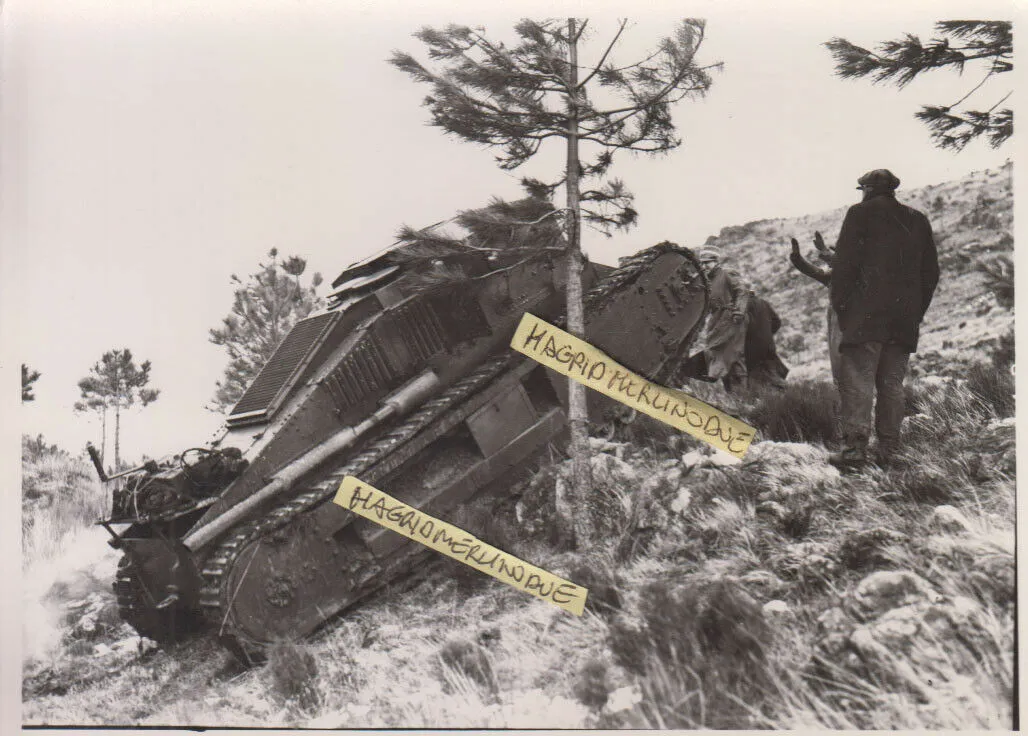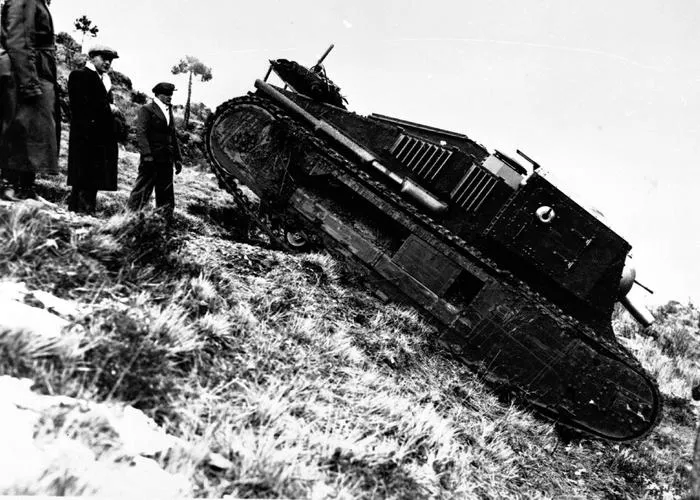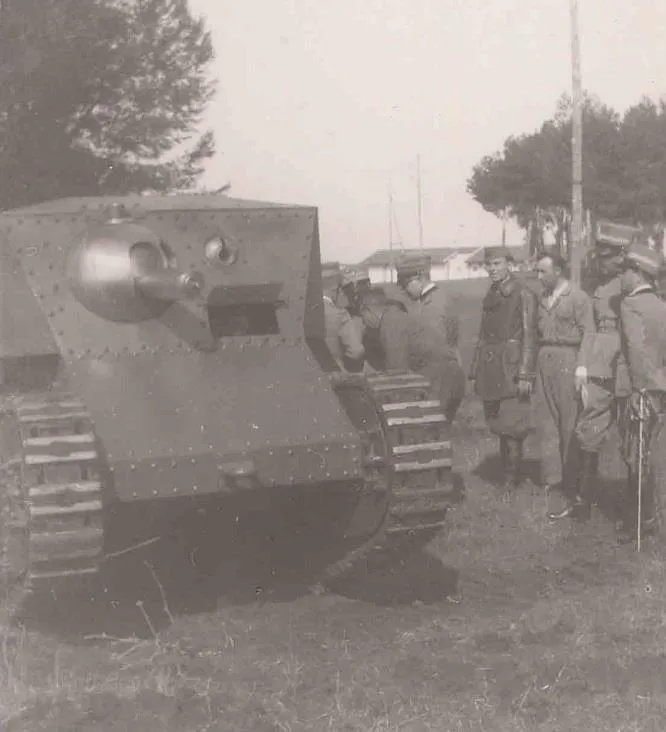- Yes (Tech Tree)
- Yes (Premium)
- Yes (Event)
- No
This is a suggestion I made on the old forums which I’m moving here… I also tweaked the post quite a bit instead of a complete copy paste.
During the early years of the interwar period, Italy was very limited on available tanks, only having the Fiat 2000 (which proved too heavy and large to suit Italian tank doctrine at the time), and the Fiat 3000, which may have been a good tank at the time, it was a design that would become outdated quickly, and the Italians knew that. They wanted a tank that could bring more firepower to the battlefield than anything the Fiat 3000, and L3 tankettes could offer while remaining small enough, and light enough to be transportable by truck, and capable of navigating the narrow, and rugged terrain of the Alps. At the same time, Britain was among the top of the game when it came to tank design, however William Foster and Co. (the company responsible for designing many of Britain’s iconic WW1 tanks, was falling behind, with Vickers being the new top dog in British tank designs. Thus the company was struggling to keep up. But due to Italy’s strong relationship with Britain at the time, evident by many of their tanks being based off of British designs (L3/33 being based off the Carden-Loyd Tankette, and M11/39 being based on the Vickers 6 ton), eventually the company would be commissioned by the Italians to design a new tank built to fulfill their need for a proper mountaineering breakthrough tank, thus the Ansaldo Carro da 9t was born.
Spoiler

A drawing at the time of the original William Foster and Co. which gives us an idea on the intended elevation/depression for the main gun, as well as a cutout showing the WW1 style road wheels.
Though designed by William Foster and Co., the tank itself was built by Ansaldo in Italy, and in 1932, the tank was complete and underwent trials soon after, at which point it was found to be rather underwhelming. The speed was nothing special, the interior, though spacious for 2 crew members, was two cramped to fit more, and though it is unclear what the original suspension system was, it most likely didn’t have any, which would result in an incredibly bumpy ride, so the vehicle would be sent back to the Ansaldo factory to be upgraded. Between 1935-1937, the tank had undergone numerous modifications, some upgrades revived were: a widened fighting compartment to increase internal space, new tracks, likely meant to improve traction and link durability, a new suspension system which heavily rambles the suspension system seen on Italy’s L3 tankettes, and identical to the suspension system used on the M11/39 prototype, with armor protecting the suspension removed, most likley to make room for the new suspension, and or keep its weight down to the 9 ton range, and some changes to the engine were made to improve operational range. However even with these modifications, the tank would never enter service because in the time it took for them to complete its modifications, Italian tank doctrine changed significantly, and the need for a WW1 style breakthrough vehicle was no more. As well development of a more promising design (the M11/39) was in full swing by the time its upgrades were finished. Thus, no more than 1 prototype was finished. (the modified version of this vehicle is what I’m suggesting). Its very likely that the knowledge gained by modifying the 9t was used to help developed the M11/39 in the latter years of the interwar era.
The top image shows the unmodified tank designed by William Foster and Co. With the red lines indicating the increased width the Italians would give the crew compartment. The middle image shows the tank with a widened crew compartment, and new tracks, but still featuring the outdated suspension. The bottom image shows the 9t with its new leaf spring suspension system, almost identical to the one on the M11/39 prototype which you can see on the left.
Sadly, many of the details regarding its exact specifications are few and far between, mainly because of the secretive nature of this project on the Italians end, as well as Britain not being too keen on advertising the fact that they had designed a tank for a nation which would later become their enemy in WW2.
Armor:
The tanks hull features a bolted (not riveted) construction, and though its exact armor thickness is unclear, it likely had armor between the thicknesses of the L3/33, and M11/39, with the side armor likely being ~10-14mm thick, and the frontal armor being greater than or equal to the side armor, though I think it would be fair to put the frontal armor at ~20mm thick, making its protection >L3/33, while being <M11/39. Regardless, the circular mantlet protecting the main armament is likely the thickest part of the armor. Another thing worth mentioning is the ammo rack placed directly below the main gun appears to be protected by thin steel, likely just thick enough to protect the ammunition against spalling.
Spoiler

Image above shows the interior of the 9t prior to being modified by the Italians, giving us a good view of the thickness of the side armor. You also have a good view of the two armaments, as well as the ammunition box below the gun breach.
Engine compartment:
Interestingly, rather than the engine, transmission, and gearbox being separated into their own parts, they were all connected to the same assembly via girders which line the inside of the hull, which means if the rear armor plates are removed, the entire mechanical assembly could be removed in one piece, to make maintenance/repairs much faster, and easier if they had the right parts. This sort of system wouldn’t be widely adopted for tanks until the 21st century, so this is really cool to see in a obscure Italian/British interwar tank
Armament:
Though the tank is armed with a 65mm cannon, its unclear as to which gun was used specifically, as it most closely resembles the Cannone da 65/17 modello.13 mountain gun, however the breech is different, and it is unclear how long the barrel is, as all of the drawings for the armament are noticeably shorter than the one actually installed on the tank, but since Italy has no other armament similar enough to compare it to, its safest to assume its a modified version of the 65/17, meaning it would have access to the same ammunition. It would have 4 ammo types total, I will be disincluding its shrapnel round as that one was designed for infantry. So the 3 ammo types which should be added to the game would be: an AP round with ~49mm of flat penetration at 100m, and a muzzle velocity of ~348m/s, HEAT with ~120mm of penetration with ~300m/s, and HE with a muzzle velocity of ~355m/s. Though I’m unsure of the exact penetration of the HE shell, it was used with relative success against T-26s during the Spanish Civil War. However due to its debatable barrel length, its possible that its muzzle velocity would be less than the numbers mentioned earlier, which would make it harder to aim for players. And though the reduced muzzle velocity will have little effect on the performance of the HE, and HEAT round, it would reduce the maximum penetration of the AP round, which depending on how much this effects the AP round, may make it not worth adding to the game at all, however if it is added, the HE round should be made default, while the AP round being easier to research than the HEAT round. The aforementioned ammo box below the main gun can hold up to 35 rounds, with the remaining storage placed under the crew seating, bringing its maximum ammo storage to 80 rounds.
The top image is a page which has details about the 65/17 modello.13 gun, the picture below that is a more up close image of the 65/17 modello.13 field
gun, the 3 images below that, which are various angles of the 65mm gun that was actually mounted to the tank, and the last image is a blueprint for the gun. You can clearly see the mismatched breech shapes between the two guns, and interestingly, you can see that the gun which was actually mounted to the tank appears to be longer than the one in the blueprint, while shorter than the 65/17. (hopefully its now obvious why there is much confusion regarding its armament).
If implemented, I think the 45 rounds under the seats should be filled first, with the storage box in the front being filled last, making the ammo harder to hit if you bring no more than 45 rounds into battle, which would then turn that metal ammo box into spaced armor of sorts if empty, That and dispite the ammo box underneath the gun likely being the first stage ammo, having it be that way would simply make the tank far to easy to kill… Also, it looks as though the main gun, and MG are rotates via strength of the operators rather than a crank as typically seen with tanks featuring turret rings, which would mean in game, the rotation of the weapons could be quite fast, especially for low tier, which would greatly improve its ability to react quickly, and or fire on the move.
The secondary armament is some 6.5mm Fiat-Revelli Model 1926 machine guns with a single ball mount in the front, 1 on each side, and 2 on the back, however most of the pictures appear to only have 1 machine gun equipped at a time, the idea being they could just remove the machine gun from one ball mount to another as needed. the tank could carry a total of 3,000 rounds for the machine gun.
Crew:
The tank would require a minimum of 2 crew members (driver, and gunner) to operate the tank, however with the increased interior space of the later model, it became possible to have a 3rd crewmate to serve as the commander, operate the machine guns, and assist with loading, and in the context of the game, would no doubt make the tank slightly more survivable.
Image above shows cutout of the engine, and fighting compartment, the Commader would be to the left of the gunner (post modification).
How it may be in game:
I can see the Carro da 9t being either below, or equal to the Semovente da 47/40 in BR, as it sacrifices armor, speed, and accuracy for a low velocity HE lobbing gun that could delete everything at its BR. I think some big factors which could make or break the functionality of this vehicle in game would be the traverse speed of the main gun, and the reload rate.
Why it should be added:
I can see this as being a much lower priority vehicle, as it wont contribute too much to Italian low tier beyond another vehicle to add to their tank destroyer tree, however beyond the M11/39, and L3/33, War Thunder doesn’t feature any other Italian interwar era tank, so it would help bring to light some of the more obscure aspects of Italian tank development at that time.
Specifications:
-Crew: 3 (Driver, Gunner, Commander(fires machine gun, and assists with loading))
-Dimensions: 4.9m long, 1.8m wide, 2m tall
-Mass: 9 tons
-Armament: 1x 65mm cannon (80 rounds), 1x 6.5mm machine gun (3,000 rounds)
-Armor: Front: ~20mm, sides/rear: ~14mm, roof/belly: <side armor
-Engine: Carraro V6 85hp-Fiat 335 75hp or Fiat 355C 80hp
-Transmission: Most likely 4 forward gears, and 1 reverse gear (like most of Italy’s tanks at the time)
-Speed: 22.5km/h (forwards), most likely between 5-7km/h (backwards)
Photo Gallery:
Spoiler






Sources:
Spoiler
Ansaldo Carro da 9t - Tank Encyclopedia
Autocannone da 65/17 su Morris CS8 - Tank Encyclopedia
Italy<br>cannone da 65/17 Mod. 1913
65/17 Mod. 1908/1913 - Wikipedia
William Foster’s Italian Tank | For the Record
Italian Medium Tanks: 1939–45 - Filippo Cappellano, Pier Paolo Battistelli - Google Books
Italian Light Tanks: 1919–45 - Filippo Cappellano, Pier Paolo Battistelli - Google Books
















